art.wikisort.org - Artist
Akseli Gallen-Kallela (26 April 1865 – 7 March 1931) was a Finnish painter who is best known for his illustrations of the Kalevala, the Finnish national epic. His work is considered a very important aspect of the Finnish national identity. He changed his name from Gallén to Gallen-Kallela in 1907.[1]
Akseli Gallen-Kallela | |
|---|---|
 | |
| Born | Axel Waldemar Gallén 26 April 1865 Pori, Finland |
| Died | 7 March 1931 (aged 65) Stockholm, Sweden |
| Nationality | Finnish |
| Known for | Painting |
| Movement | Romantic nationalism, Realism, Symbolism |
Life and career
Early life
Gallen-Kallela was born Axel Waldemar Gallén in Pori, Finland, in a Swedish-speaking family. His father Peter Gallén worked as police chief and lawyer.[2] Gallen-Kallela was raised in Tyrvää.[3] At the age of 11 he was sent to Helsinki to study at a grammar school, because his father opposed his ambition to become a painter. After his father's death in 1879, Gallen-Kallela attended drawing classes at the Finnish Art Society (1881–1884) and studied privately under Adolf von Becker.[1]
Paris

In 1884 he moved to Paris, to study at the Académie Julian.[4] In Paris he became friends with the Finnish painter Albert Edelfelt, the Norwegian painter Carl Dørnberger, and the Swedish writer August Strindberg.[1] During this period he traveled back and forth between Finland and Paris.[1]
 Life and Death, 1884
Life and Death, 1884- Parisian Backyard, 1884 (fi)
- Old Woman with a Cat, 1885 (fi)
- Boulevard in Paris, 1885 (fi)
- In a Café in Paris, 1886
- Woman Cooking Whitefish, 1886
- Rustic Life, 1887 (fi)
- The First Lesson, 1887–1889
- Démasquée, 1888 (fi)
- In the Sauna, 1889 (fi)
- Wound Fever, 1889 (fi)
Mary Slöör


He married Mary Slöör in 1890. The couple had three children, Impi Marjatta, Kirsti and Jorma. On their honeymoon to East Karelia, Gallen-Kallela started collecting material for his depictions of the Kalevala. This period is characterized by romantic paintings of the Kalevala, such as the Aino Myth, and by several landscape paintings, although by 1894 the influence of symbolism is heavily visible in his works.[1]
Berlin and tragedy

In December 1894, Gallen-Kallela moved to Berlin to oversee the joint exhibition of his works with the works of Norwegian painter Edvard Munch. At the time Gallen-Kallela also designed a grand cabin called Kalela for his family far from everything on the shore of Lake Ruovesi. It was built from dead standing pine by 13 local carpenters in a year from 1894 to 1895.[11][12]
In March 1895, his trip was ended when he received a telegram that his daughter Impi Marjatta had died from diphtheria. This would prove to be a turning point in his work. While his works had previously been romantic, after his daughter's death Gallen-Kallela painted more aggressive works. In the years 1896–1899 he painted what are considered his most famous works: The Defense of the Sampo, Lemminkäinen's Mother, Joukahainen's Revenge and Kullervo's Curse.[1] In May 1895, Gallen and Mary visited London, with his intent being the purchase of a graphic art press. While there he also learned about stained glass. At the end of 1897 the family took a trip to Florence, also visiting Pompeii, where he studied the art of frescoes.[1]
- Portrait of Edvard Munch, 1895
- Kalela on a Winter Night, 1896
 The Artist's Mother, 1896
The Artist's Mother, 1896- The Defense of the Sampo, 1896 (fi)
- Lemminkäinen's Mother, 1897
- Joukahainen's Revenge, 1897 (fi)
- The Fratricide, 1897, from Kanteletar
- Mary Sewing on the Veranda of Kalela, 1897
- Kullervo's Curse, 1899 (fi)
- February Vision, 1899
Paris 1900 Exposition
For the Paris World Fair in 1900, Gallen-Kallela painted frescoes for the Finnish Pavilion.[1] In the fresco Ilmarinen Plowing the Field of Vipers there was a hidden political message: one of the vipers is wearing a small Romanov crown,[13] telling of Gallen-Kallela's wish for an independent Finland at the time of the Russification of Finland.
The Paris Exposition secured Gallen-Kallela's stature as the leading Finnish artist.[14] In 1901 he was commissioned to paint the fresco, Kullervo Sets Off for War, for the concert hall of the Helsinki Student's Union.[14] Between 1901 and 1903 he painted the frescoes for the Jusélius Mausoleum in Pori, memorializing the 11-year-old daughter of the industrialist Fritz Arthur Jusélius. (The frescoes however were soon damaged by dampness, and were completely destroyed by fire in December 1931. Jusélius assigned the artist's son Jorma to repaint them from the original sketches.[15] The reconstruction was completed just before Jorma's death in 1939.)[1]
Gallen-Kallela officially finnicized his name to the more Finnish-sounding Akseli Gallen-Kallela in 1907.[1] His idea for a 700-page Great Kalevala was fully formed in 1909 with a publication of his plan in the Valvoja magazine.[16]
- Sketch for the 1900 Exposition fresco Ilmarinen Plowing the Field of Vipers, 1899
- Liekki rya, designed by Gallen-Kallela
- Spring, c. 1900
[note 4]  Kullervo Sets Off for War, 1901, large mural at Old Student House
Kullervo Sets Off for War, 1901, large mural at Old Student House- By the River of Tuonela, study for the Jusélius Mausoleum frescos, 1903 (fi)
- Lake Keitele, 1905[17] (fi)
- The Theft of the Sampo, 1905 (fi)
- The Departure of Väinämöinen, 1906 (fi)
 The Lair of the Lynx, 1906
The Lair of the Lynx, 1906- Bil-Bol, Poster for an Automobile Retailer, 1907
Kenya


In 1908 with renewal in mind, Gallen-Kallela and his family moved to Paris. However the city and the new direction art was being taken didn't feel as hospitable as he had hoped, and so in May 1909 they moved much further away to Nairobi in Kenya. He was the first Finnish artist to paint south of the Sahara, and he totalled over 150 expressionistic works. Although artistically the paintings are of fluctuating quality, their colors and the synergy of the colors are remarkable. They returned to Finland in February 1911.[1] Between 1911 and 1913 he designed and built a studio and house for his family at Tarvaspää, approximately 10 km northwest of the centre of Helsinki.[18]
- The Oceanides, 1909
- Café in Paris, 1909
- Skeleton of a Camel, 1909
- Untitled, 1909
- Kikuyu Woman, 1909
- Portrait of Kenosua, 1909–1910
[note 5] - Rhinoceros and Euphorbia Trees, 1909–1910
- Hippos in the Tana River, 1910
- Homo Victor (Victorious Man), 1910
- Coral Tree in Blossom, 1910
Finnish Civil War


The family moved back from Tarvaspää to Kalela in 1915 to escape the turmoil of WW I. A few years later in 1918, Gallen-Kallela and his son Jorma took part in the fighting at the front of the Finnish Civil War. When the regent, General Mannerheim, heard about this, he invited Gallen-Kallela to design the flags, official decorations and uniforms for the newly independent Finland. For the flag, Gallen-Kallela proposed a white-blue cross flag, with colors inverted (white cross on blue), but this was considered too similar to the Swedish flag and particularly the Greek flag of the time. In 1919 he was appointed aide-de-camp to Mannerheim.[1] In 1920 he made an agreement with the publishing company WSOY for the eventual publication of Great Kalevala, with the less decorative Koru-Kalevala being published first in 1922.[16]
Taos, New Mexico, and later life

In December 1923 he moved to the United States, where his family also followed him in autumn 1924. He first spent time in Chicago, and an exhibition of his work toured several cities.[20] In Chicago he was impressed by Native American art and moved to Taos, New Mexico, at the art colony there to study it further. During this time in the United States he also began sketching out the Great Kalevala in much more detail. In May 1926, the family returned to Finland. Two years later in 1928 together with his son Jorma he painted the Kalevala frescoes at the lobby of the National Museum of Finland. Then in 1930 he made an agreement to paint a gigantic fresco for the bank Kansallis-Osake-Pankki, but on 7 March 1931 while returning from a lecture in Copenhagen he suddenly died of pneumonia in Stockholm.[1]
- Indian Chief Clear Water, 1924
- The Indian Sia Ohutaa, 1925
- Our Home in Taos, 1925
- Taos Home in Sunlight, 1925
- Indian on Horseback in Snow, 1925
- Taos, 1925
- Crack Willow and Blue Bird in New Mexico, 1925
- The Great Pike, 1928 fresco based on an earlier a 1904 painting
- Portrait of Carl Gustaf Emil Mannerheim, 1929
- Page depicting the birth of Väinämöinen from the unfinished Great Kalevala, 1920–1930
Legacy
His studio and house at Tarvaspää was opened as the Gallen-Kallela Museum in 1961; it houses some of his works and research facilities on Gallen-Kallela himself.[21][22]
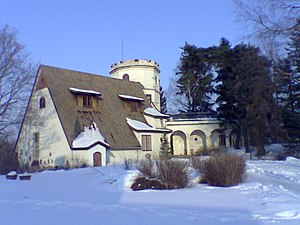
See also
- Golden Age of Finnish Art
- Finnish art
Notes
- The girl who modeled for the painting was a future parliament member, Maria Raunio.<ref name='FOOTNOTEPohjolainen2016'>Pohjolainen 2016.
- The frames were painted by Elin Danielson-Gambogi.[6]
- Gallen-Kallela was inspired by Sibelius' tone poem En saga (A Fairy Tale). On the right is Sibelius himself, at top left is the visuals it brought to Gallen-Kallela's mind and the empty section at bottom left was supposed to have notes from the tone poem, but Sibelius didn't wish to add them.[9][10]
- There is also a Jusélius Mausoleum fresco called Spring from 1903.
- He was an aide and a friend to the Gallen-Kallela family and always escorted the family's children to school.[19]
References
Citations
- Reitala 1997.
- Martin & Pusa 1985, p. 5.
- Musée d'Orsay 2012.
- Martin & Pusa 1985, p. 65.
- Hämäläinen 2018.
- Okkonen 1916, pp. 248–261.
- Sipilä 2019.
- Leppänen 2020.
- Ainola.
- von Donsdorff 2017.
- Ruovesi.
- Yle 2010.
- Saressalo 2018.
- Martin & Pusa 1985, p. 12.
- Martin & Pusa 1985, p. 37.
- Mikkonen 2017.
- Aksa 2018.
- Martin & Pusa 1985, p. 38.
- Kulttuurikurkkaus 2019.
- Martin & Pusa 1985, p. 39.
- Gallen-Kallela Museum 2015.
- Ringbom 1996.
Sources
Books
- Jackson, D.; Wageman, P., eds. (2006). Akseli Gallen-Kallela, De magie van Finland [Akseli Gallen-Kallela, The Magic of Finland] (softcover) (in Dutch). Rotterdam: NAi Booksellers / Groninger Museum. ISBN 978-90-5662-523-8.
- Martin, Timo; Pusa, Erja (1985). Akseli Gallen-Kallela, 1865-1931 (hardcover). Translated by John Derome. Tarvaspää: Gallen-Kallela Museum. OCLC 29071282.
- Okkonen, Onni (1916). "Trip to Kuusamo". Akseli Gallen-Kallela, elämä ja taide [Akseli Gallen-Kallela, life and art] (in Finnish). Porvoo-Helsinki: Werner Söderström Osakeyhtiö (WSOY).
- Pohjolainen, Raija (2016). Tyttö Keuruun vanhassa kirkossa [A girl in the old church in Keuruu] (in Finnish). Vantaa: Kellastupa. ISBN 978-95-2578-723-8.
Websites
- "Ainolan taideteokset / Aino ja Jean Sibeliuksen koti" [Welcome to Ainola! / The home of Aino and Jean Sibelius]. Ainola (in Finnish). Retrieved 22 August 2020.
- "Akseli Gallen-Kallela (1865-1931). A Passion for Finland". Musée d'Orsay. 2012. Retrieved 30 November 2018.
- "Akseli Gallen-Kallela ikuisti Keitelettä – teoskopio sai paikan Lintulahden Nesteeltä" [Akseli Gallen-Kallela immortalized Keitele - a copy of the work was received from Lintulahti Neste]. Aksa (in Finnish). 9 December 2018. Retrieved 21 August 2020.
- "Gallen-Kallela 150 years". Gallen-Kallela Museum. 2015. Retrieved 4 January 2017.
- "Gallen-Kallelan rapistunut erämaa-ateljee avataan heinäkuuksi" [The dilapidated wilderness studio in Gallen-Kallela will open in July]. Yle (in Finnish). 29 June 2010. Retrieved 21 August 2020.
- Hämäläinen, Jukka (24 May 2018). "Suomen Pankki esittelee taideaarteitaan avoimin ovin – Tiesitkö että Aino-triptyykistä on kaksi erilaista versiota?" [The Bank of Finland presents its art treasures openly - Did you know that there are two different versions of the Aino triptych?]. Vantaan Sanomat (in Finnish). Retrieved 21 August 2020.
- "Kalela". Ruovesi. Retrieved 21 August 2020.
- "Kulttuurikurkkaus" [Cultural corner] (PDF). Gallen-Kallela Museum (in Finnish). August 2019. Retrieved 22 August 2020.
- Leppänen, Mikko (23 January 2020). "Gallen-Kallelan Palokärki päätyi pariisilaiseen taidemuseoon" [Gallen-Kallela's Palokärki ended up in an art museum in Paris]. Yle (in Finnish). Retrieved 21 August 2020.
- Mikkonen, Nadja (19 September 2017). "Suur-Kalevala oli Akseli Gallen-Kallelan hurja haave – haukkui kirjeellä kustantajan, kun ymmärrystä ei löytynyt" [The Great Kalevala was Akseli Gallen-Kallela's wild dream - the publisher barked with a letter when no understanding was found]. Yle (in Finnish). Retrieved 25 August 2020.
- Reitala, Aimo (16 September 1997). "Gallen-Kallela, Akseli (1865–1931)". 100 Faces from Finland – a Biographical Kaleidoscope. Translated by Fletcher Roderick. Biographical Centre of the Finnish Literature Society. Retrieved 4 February 2017.
- Ringbom, Sixten (1996). "Gallen-Kallela, Akseli (1865–1931), painter, graphic artist, designer". Grove Art Online. Oxford Index. Retrieved 4 February 2017.
- Saressalo, Lassi (2018). "Matka kultakauteen Kansallisromantiikkaa Kainuusta ja kauempaakin" [A journey into the golden age National romance from Kainuu and beyond]. Kotiseutuliitto (in Finnish). Retrieved 20 August 2020.
- Sipilä, Annamari (4 November 2019). "Mysteeriomistajalla vuosikymmeniä ollut Gallen-Kallelan miljoonateos Palokärki tulee myyntiin New Yorkissa – lintuun kiteytyy suomalaisten vastarinta" [Gallen-Kallela's millennial work Palokärki, which has had a mystery owner for decades, goes on sale in New York - Finnish bird crystallizes resistance]. Helsingin Sanomat (in Finnish). Retrieved 21 August 2020.
- von Donsdorff, Anna-Maria (2017). "Correspondences – Jean Sibelius in a Forest of Image and Myth" (PDF). FNG Research. Retrieved 22 August 2020.
External links
![]() Media related to Akseli Gallen-Kallela at Wikimedia Commons
Media related to Akseli Gallen-Kallela at Wikimedia Commons
- List of all paintings by Gallen-Kallela on Commons
- Gallen-Kallela Museum website
- "Akseli Gallen-Kallela". Biografiskt lexikon för Finland (in Swedish). Helsingfors: Svenska litteratursällskapet i Finland. urn:NBN:fi:sls-4673-1416928957279.
На других языках
[de] Akseli Gallen-Kallela
Akseli Gallen-Kallela (* 26. April 1865 in Pori, Großfürstentum Finnland als Axel Waldemar Gallén; † 7. März 1931 in Stockholm in Schweden) war ein finnischer Maler, Architekt und Designer. Er ist besonders für seine Illustrationen zum finnischen Nationalepos Kalevala bekannt und gilt als bedeutendster Vertreter der finnischen Nationalromantik in der Bildenden Kunst.- [en] Akseli Gallen-Kallela
[es] Akseli Gallen-Kallela
Akseli Gallen-Kallela (Pori, Finlandia, 26 de abril de 1865 - Estocolmo, Suecia, 7 de marzo de 1931) fue un artesano, ilustrador y pintor finlandés, muy conocido por sus ilustraciones del Kalevala, el poema épico nacional finés. Su trabajo se considera muy importante en el surgimiento del sentimiento nacional de ese país.[fr] Akseli Gallen-Kallela
Akseli Gallen-Kallela de son vrai nom Axel Waldemar Gallén[o 1] (né le 26 avril 1865 à Pori, en Finlande, et mort le 7 mars 1931 à Stockholm, en Suède) est un peintre et graveur finlandais de la fin du XIXe et du début du XXe siècle. Il fut l'un des artistes finlandais les plus connus internationalement. Son œuvre est associée aux styles nationaliste romantique, symboliste et réaliste.[it] Akseli Gallen-Kallela
Akseli Gallen-Kallela, nato con il nome di Axél Waldemar Gallén (Pori, 26 aprile 1865 – Stoccolma, 7 marzo 1931), è stato un pittore finlandese, conosciuto soprattutto per le sue illustrazioni del Kalevala, il poema epico nazionale finlandese.[ru] Галлен-Каллела, Аксели
Аксели Галле́н-Ка́ллела (фин. Akseli Gallen-Kallela), урождённый Аксель Вальдемар Галлен (швед. Axel Waldemar Gallén), 26 апреля 1865, Бьёрнеборг, Великое княжество Финляндское — 7 марта 1931, Стокгольм, Швеция) — финский художник шведского происхождения, наиболее известный по иллюстрациям к Калевале. Видный представитель «золотого века» финского искусства периода 1880—1910 годов. В период пробуждения финского национального движения, когда начался массовый перевод иностранных фамилий на финский язык, изменил свою шведскую фамилию «Галлен» на финский манер — «Каллела», и объединил оба написания в двойную фамилию.Другой контент может иметь иную лицензию. Перед использованием материалов сайта WikiSort.org внимательно изучите правила лицензирования конкретных элементов наполнения сайта.
WikiSort.org - проект по пересортировке и дополнению контента Википедии

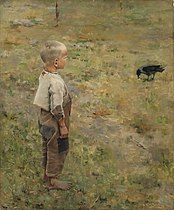




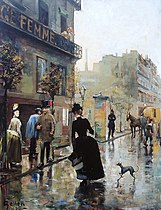







![Girl in the Old Church of Keuruu, 1889 (fi)[note 1]](http://upload.wikimedia.org/wikipedia/commons/thumb/5/5a/Akseli_Gallen-Kallela_Tytt%C3%B6_Keuruun_vanhassa_kirkossa.jpg/131px-Akseli_Gallen-Kallela_Tytt%C3%B6_Keuruun_vanhassa_kirkossa.jpg)

![Aino Myth, Triptych, 1891[5] (fi)](http://upload.wikimedia.org/wikipedia/commons/thumb/1/17/Gallen_Kallela_The_Aino_Triptych.jpg/436px-Gallen_Kallela_The_Aino_Triptych.jpg)

![Mäntykoski Waterfall, 1892–1894 (fi)[note 2]](http://upload.wikimedia.org/wikipedia/commons/thumb/3/3d/Akseli_Gallen-Kallela_-_M%C3%A4ntykoski_Waterfall_%28with_frames%29.jpg/129px-Akseli_Gallen-Kallela_-_M%C3%A4ntykoski_Waterfall_%28with_frames%29.jpg)


![Black Woodpecker, 1894[7][8] (fi)](http://upload.wikimedia.org/wikipedia/commons/thumb/b/bb/Palok%C3%A4rki_by_Akseli_Gallen-Kallela.jpg/129px-Palok%C3%A4rki_by_Akseli_Gallen-Kallela.jpg)

![Sibelius as the Composer of En saga, 1894[note 3]](http://upload.wikimedia.org/wikipedia/commons/thumb/b/be/Akseli_Gallen-Kallela_-_Sibelius_as_the_Composer_of_En_saga.jpg/305px-Akseli_Gallen-Kallela_-_Sibelius_as_the_Composer_of_En_saga.jpg)













![Spring, c. 1900[note 4]](http://upload.wikimedia.org/wikipedia/commons/thumb/f/fc/Akseli_Gall%C3%A9n-Kallela_-_Fr%C3%BChjahr_-_419_-_%C3%96sterreichische_Galerie_Belvedere.jpg/125px-Akseli_Gall%C3%A9n-Kallela_-_Fr%C3%BChjahr_-_419_-_%C3%96sterreichische_Galerie_Belvedere.jpg)


![Lake Keitele, 1905[17] (fi)](http://upload.wikimedia.org/wikipedia/commons/thumb/9/94/Akseli_Gallen-Kallela_-_Lake_Keitele%2C_1905.JPG/270px-Akseli_Gallen-Kallela_-_Lake_Keitele%2C_1905.JPG)






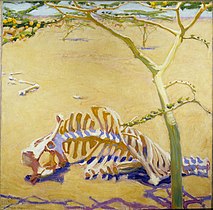


![Portrait of Kenosua, 1909–1910[note 5]](http://upload.wikimedia.org/wikipedia/commons/thumb/2/28/Akseli_Gallen-Kallela_-_Portrait_of_Kenosua.jpg/149px-Akseli_Gallen-Kallela_-_Portrait_of_Kenosua.jpg)



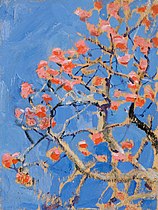















![Page depicting the birth of Väinämöinen from the unfinished Great Kalevala [fi], 1920–1930](http://upload.wikimedia.org/wikipedia/commons/thumb/b/b8/The_Great_Kalevala-_Poem_I%2C_verses_301_-_334_%28crop%29.jpg/154px-The_Great_Kalevala-_Poem_I%2C_verses_301_-_334_%28crop%29.jpg)